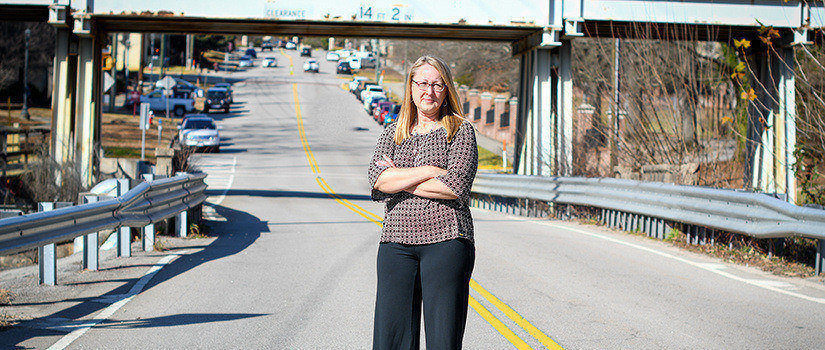Gassman’s $1.7 million collaboration with SCDOT and Clemson to benefit drivers across the state
Sarah Gassman, an associate professor of civil and environmental engineering in the College of Engineering and Computing, is part of a research study that will help the S.C. Department of Transportation (SCDOT) better calibrate its pavement design to local climate and traffic conditions for increased longevity and performance.
The research is expected to lead to improvements in road quality and durability for the betterment of all South Carolina drivers.
Gassman said, “When the DOT better understands how pavement materials perform in traffic and climate conditions, then it can better design those pavements. Driving down the road, we all encounter cracks and potholes. A better understanding of the materials will tell us how long pavement will last and the best way to repair and rehabilitate our roads.”
Gassman is working in conjunction with the SCDOT Office of Materials and Research and Clemson University on the $1.7 million study, funded by SCDOT and the Federal Highway Administration (FHWA). The motivation for the study came several years ago with the release of the FHWA’s new pavement design methodology, which requires large amounts of data such as material design properties, climate and performance data and traffic loading data, some of which the SCDOT was lacking. During Phase I of the study, which began in 2017, the team worked to assess what data was on file and what was needed.
SCDOT Pavement Design Engineer Eric Carroll said, “The current pavement design method is useful due to the experience that has been developed over the years; however, it is limited in its ability to incorporate new paving materials, specification changes and higher traffic volumes that were not part of the original calibration.”
Now in Phase II, the team has been working to obtain the needed data through field and lab studies. Gassman said, “We are aiming to have as much material and traffic data as possible to design with the new methodology. We’re taking distress surveys, counting and measuring cracks, and running tests on soil and asphalt samples in order to understand their behavior.”
Phase II is expected to conclude early next year with a recommended design for new pavements based on the data obtained by the research team. The SCDOT will make decisions regarding a possible Phase III based on the team’s input from Phase II. A third phase would analyze the best strategy for existing pavement rehabilitation, such as by removing and replacing top layers or total reconstruction.
Carroll said, “The method the team is working to calibrate should allow the DOT to more accurately assign material inputs used in each pavement layer in addition to giving the designer a better understanding of the distresses and failure mechanisms that will be caused by traffic loadings and environmental conditions. Once implemented, the findings should allow the department to design and construct a lower life cycle cost pavement resulting in a cost savings for the department and taxpayers.”
Sarah Gassman is an associate professor of civil and environmental engineering in the College of Engineering and Computing. Specializing in geotechnical engineering, her research interests include projects focused on the mechanistic behavior of subgrade soils for pavement design; evaluation of pavement performance; effect of soil aging on liquefaction potential; and non-destructive evaluation of foundations and bridge structures.
